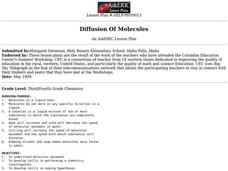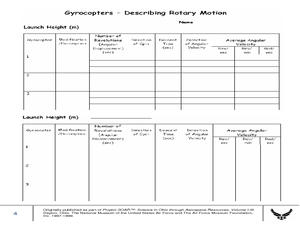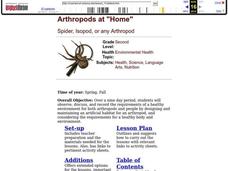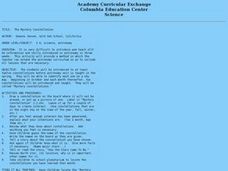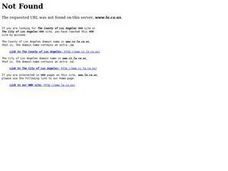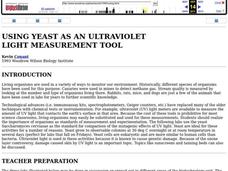Curated OER
All I Want for Christmas is a Nice, Clean Earth
Young scholars observe properties of items, determine time it takes for organic/inorganic items to decompose, identify differences/similarities between decomposition, identify practical uses in litter/garbage control, & establish...
Curated OER
Pigment Plucking
Students examine pigments found in different fruits and vegetables and practice the processes for extracting the pigments. Pigments are used to create artwork and a class PowerPoint presentation is made on the different types of plant...
Curated OER
Diffusion Of Molecules
Students investigate molecular movement while studying how to perform a chemistry investigation.
Curated OER
Insect Matching
Third graders match insects to the proper order based on the characteristics. They culminate their study of the orders that insects belong in by looking at insects with magnifying glasses.
Curated OER
Bird Research: Your First Investigation
In this bird research instructional activity, students keep a notebook and record their observations every day for a week about the birds they see with discussion questions at the end of the week.
Curated OER
Gyrocopter - Describing Rotary Motion
Students calculate angular displacement, velocity and acceleration of gyrocopters. In this physics lesson, students compare data taken from 3 different gyrocopters. They explain how differences in construction material affect rates of...
Curated OER
Arthropods at
Young scholars observe, discuss, and record the requirements of a healthy environment for both arthropods and people by designing and maintaining an artificial habitat for an arthropod.
Curated OER
The Mystery Constellation
Students decipher two teacher chosen mystery constellations a month. They listen to stories, explain what they know about constellations and name the mystery constellation.
Curated OER
Ride the Wave!
Young scholars examine how sonar works. They discuss the concept of sound waves, observe a demonstration of how sonar works using water, pie plates, and eyedroppers, and describe how sonar works in their own words.
Curated OER
Dino Fossils
Primary paleontologists discover the information they can gather from examining fossils. They place pictures in the correct sequence showing how an animal becomes a fossil. They discuss which sediments would preserve fossils better as well.
Curated OER
Video Umpires
Students play umpire in a baseball game. They video the umpire's calls and then examine the accuracy of a "line call" when compared to a taped record of a ball's exact impact location. They create a transcript of a fictional court case...
Curated OER
Where is Water Found?
Fourth graders examine the amount of water and its distribution on Earth. As a class, they brainstorm a list of where water can be found and classify the places according to salt water, fresh water or glaciers. They estimate how much...
Curated OER
Wet Weather, Wet Climate
Students discover the differences between weather and climate in this long-term lesson introduction. They create rain gauges and practice reading rainfall measurements, view a website showing the cloud cover in their location and draw...
Curated OER
Probes, Exploration & Application
Students explore how a surface can be described without seeing it.
Curated OER
Classifying Organisms within Kingdoms
Students examine animal kingdom classifications. They discuss how animals are placed into kingdom classifications and compare similarities and differences of animals within a kingdom.
Curated OER
As the Sun Burns
Students test commercial sunscreens or sunglasses for accuracy of their Sun Protection Factor. They devise a method for testing UV beads with a visual clues which they publish as research. They investigate occupations such as...
Curated OER
The Great Spider Debate
Learners study about the survival and hunting strategies of several different kinds of spiders. They also be introduced to scientific classification of spiders and write a brief report about one of the spider families they observe.
Curated OER
Where Next?
Students read an article explaining NASA's possible Mars landing sites. They use the Internet to research Mars and the Module. They are able to submit their own proposals for a landing site after researching the planet.
Curated OER
The Magic School Bus Out of this World
Students explore the craters that objects of different sizes and weights make. They use marbles, Ping-Pong balls, and aluminum-foil balls for this experiment. They investigate what would happen if they drop objects that aren't round.
Curated OER
Streamflow
Learners discuss the topic of streamflow and how it occurs. They take measurements and analyze them. They interpret data and create their own charts and graphs.
Curated OER
Using Yeast as an Ultraviolet Light Measurement Tool
Students accurately measure the relationship between radiation dose and either survival or some genetic event such as mutation or recombination. They investigate the damage that was done to the DNA molecule as a result of exposure to...
Curated OER
Deserts KWL Chart
Students will define what a desert is through the creation of a KWL Chart. This will help students to tap prior knowledge and make new connections with the new curriculum being delivered in the lesson.
Curated OER
Measuring and Identifying Trees with the Help of Technology
Students arrange themselves into small groups. Each group chooses a distance to measure ( the distance between the slide and the swings, for instance). Person #1 walks the distance, counting the number of his or her steps. Persons 2...





